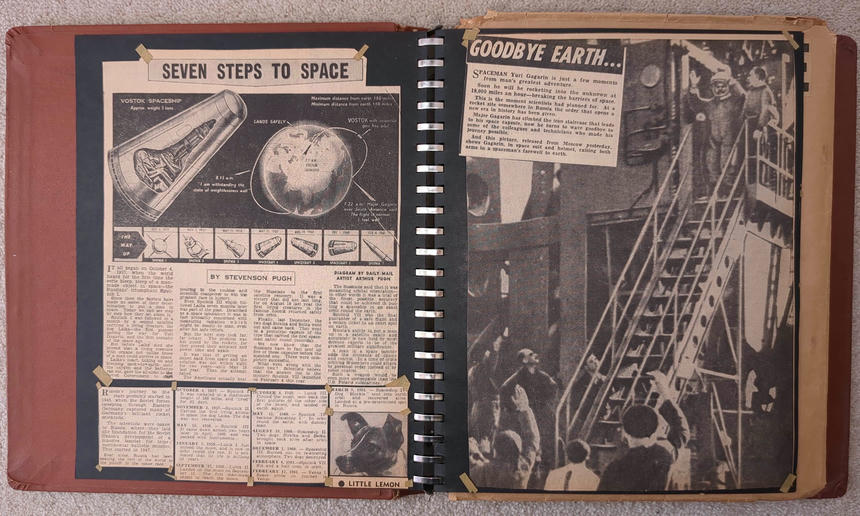Scrapbook 1: Apr 1961 — Gagarin

SEVEN STEPS TO SPACE
BY STEVENSON PUGH
It all began on October 4, 1957, when the world heard for the first time the eerie bleep, bleep of a man-made object in space—the Russians’ triumphant Sputnik I.
Since then the Soviets have made no secret of their determination to put a man in space. Today we can see step by step how they set about it.
Sputnik I was followed in a month by a second satellite carrying a living creature, the dog Laika—the first pioneer paving the way for Yuri Gagarin, and the first casualty of the space age.
But before Laika died she proved that a living creature with organs not unlike those of a man could survive in space.
Laika’s heart, ticking on and bleeping back to earth until the oxygen and the batteries ran out, gave the all-clear to the Soviet Government to start pouring in the roubles and scientific manpower to win the greatest race in history.
Even Sputnik III which followed Laika seven months later was part of the plan. Described as a space laboratory it was in fact primarily concerned with measuring radiation which might be deadly to man, even after his safe return.
But the next step took far, far longer. The problem was not posed by the rockets, for they proved their accuracy and power time and again.
It was that of getting an object back from space and the solution was not within sight for two years—until May 15 last year. Then the attempt failed.
The Americans actually beat the Russians to the first satellite recovery. It was a victory that did not last long, for on August 19 last year the first living creatures in the famous Zoonik returned safely from orbit.
Finally, last December, the two dogs Strelka and Belka went out and came back. They went in a prototype capsule of the type that carried the first spaceman safely round yesterday.
We now know that the Russians have in fact sent up five of these capsules before the manned one. Three were completely successful.
What went wrong with the other two? Scientists believe that the answer lies in the mystery Sputnik VII launched on February 4 this year.
The Russians said that it was measuring orbital orientation—in other words it was a trial of the finest possible accuracy that could be achieved in putting a spaceship in an exact orbit round the earth.
Sputnik VII was the final guarantee of a safe flight and a return ticket to an exact spot on earth.
Russia’s ability to put a man up in a satellite easily and accurately is now held by most defence experts to be of the greatest military significance.
A man in a space bomber adds the elements of choice and control. In a time of crisis orbiting H-bombers could attack by personal order instead of by robot control.
Such a weapon would be even more unstoppable than the U.S. Polaris submarines.
Russia’s Journey to the stars probably started in 1945, when the Soviet forces sweeping through Eastern Germany captured many of Germany’s brilliant rocket scientists.
The scientists were taken to Russia, where they laid the foundation for the Soviet Union’s development of a massive booster for inter-continental ballistic missiles. This started in 1947.
Ever since, Russia has been beating the rest of the world to the punch in the space race:
OCTOBER 4. 1957. — Sputnik I. It was rocketed to a maximum height of 588 miles, and “lived” for 92 days.
NOVEMBER 3, 1957.—Sputnik II. Carried the first living animal in space, the dog Laika. The dog was not recovered.
MAY 15, 1958, — Sputnik III. It came down almost two years later In April, 1960, and was packed with instruments,
JANUARY 2. 1959.—Lunik I. Just missed the moon, and is now in orbit round the sun. It is estimated that its life is millions of years.
SEPTEMBER 12, 1959,—Lunik II. Landed on the moon on September 13. The first man-made object to reach the moon.
OCTOBER 4. 1959. — Lunik III. Circled the moon, sent back the first pictures of the other side of the moon, and landed on earth again.
MAY 15. 1960. — Sputnik IV. became Spaceship I. In orbit round the earth, with dummy man.
AUGUST 19, 1960.—Spaceship II. Two dogs, Strelka and Belka, brought back alive after orbit in space.
DECEMBER 1, 1960. — Spaceship III. Burned out on re-entering atmosphere. Two dogs destroyed.
FEBRUARY 4, 1961.—Sputnik VII. Six and a half tons, in orbit.
FEBRUARY 12, 1961. — Venus I. Space probe on journey to Venus.
MARCH 9. 1961. — Spaceship IV. Dog “Blackie” sent into earth orbit and recovered alive. Landed at a pre-determined spot in Russia.
LITTLE LEMON
GOODBYE EARTH…
SPACEMAN Yuri Gagarin is just a few moments from man’s greatest adventure.
Soon he will be rocketing into the unknown at 18,000 miles an hour—breaking the barriers of space.
This is the moment scientists had planned for. At a rocket site somewhere in Russia the order that opens a new era in history has been given.
Major Gagarin has climbed the iron staircase that leads to his space capsule, now he turns to wave goodbye to some of the colleagues and technicians who made his journey possible.
And this picture, released from Moscow yesterday, shows Gagarin, in space suit and helmet, raising both arms in a spaceman’s farewell to earth.